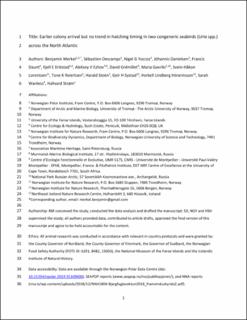| dc.contributor.author | Merkel, Benjamin | |
| dc.contributor.author | Descamps, Sebastien | |
| dc.contributor.author | Yoccoz, Nigel Gilles | |
| dc.contributor.author | Danielsen, Jóhannis | |
| dc.contributor.author | Daunt, Francis | |
| dc.contributor.author | Erikstad, Kjell E | |
| dc.contributor.author | Ezhov, Aleksey V. | |
| dc.contributor.author | Grémillet, David | |
| dc.contributor.author | Gavrilo, Maria | |
| dc.contributor.author | Lorentsen, Svein Håkon | |
| dc.contributor.author | Reiertsen, Tone Kristin | |
| dc.contributor.author | Steen, Harald | |
| dc.contributor.author | Systad, Geir Helge Rødli | |
| dc.contributor.author | Þórarinsson, Þorkell Lindberg | |
| dc.contributor.author | Wanless, Sarah | |
| dc.contributor.author | Strøm, Hallvard | |
| dc.date.accessioned | 2021-10-27T11:46:35Z | |
| dc.date.available | 2021-10-27T11:46:35Z | |
| dc.date.created | 2019-10-24T15:52:19Z | |
| dc.date.issued | 2019 | |
| dc.identifier.issn | 1744-9561 | |
| dc.identifier.uri | https://hdl.handle.net/11250/2826008 | |
| dc.description.abstract | A global analysis recently showed that seabird breeding phenology (as the timing of egg-laying and hatching) does not, on average, respond to temperature changes or advance with time (Keogan et al. 2018 Nat. Clim. Change 8, 313–318). This group, the most threatened of all birds, is therefore prone to spatio-temporal mismatches with their food resources. Yet, other aspects of the breeding phenology may also have a marked influence on breeding success, such as the arrival date of adults at the breeding site following winter migration. Here, we used a large tracking dataset of two congeneric seabirds breeding in 14 colonies across 18° latitudes, to show that arrival date at the colony was highly variable between colonies and species (ranging 80 days) and advanced 1.4 days/year while timing of egg-laying remained unchanged, resulting in an increasing pre-laying duration between 2009 and 2018. Thus, we demonstrate that potentially not all components of seabird breeding phenology are insensitive to changing environmental conditions. guillemots, murres, pre-laying period, timing of egg-laying, Uria aalge, Uria lomvia | en_US |
| dc.language.iso | eng | en_US |
| dc.publisher | Royal Society of Chemistry | en_US |
| dc.title | Earlier colony arrival but no trend in hatching timing in two congeneric seabirds (Uria spp.) across the North Atlantic | en_US |
| dc.type | Peer reviewed | en_US |
| dc.type | Journal article | en_US |
| dc.description.version | acceptedVersion | en_US |
| dc.rights.holder | This is the authors' accepted manuscript to an article published by Royal Society of Chemistry. | en_US |
| dc.subject.nsi | VDP::Zoologiske og botaniske fag: 480 | en_US |
| dc.subject.nsi | VDP::Zoology and botany: 480 | en_US |
| dc.source.volume | 15 | en_US |
| dc.source.journal | Biology Letters | en_US |
| dc.identifier.doi | 10.1098/rsbl.2019.0634 | |
| dc.identifier.cristin | 1740335 | |
| dc.relation.project | Andre: Norwegian Oil and Gas Association | en_US |
| dc.relation.project | Andre: Norwegian Ministry of Foreign Affairs | en_US |
| dc.relation.project | Norges forskningsråd: 216547 | en_US |
| cristin.unitcode | 194,0,0,0 | |
| cristin.unitname | Norges teknisk-naturvitenskapelige universitet | |
| cristin.ispublished | true | |
| cristin.fulltext | original | |
| cristin.qualitycode | 2 | |
